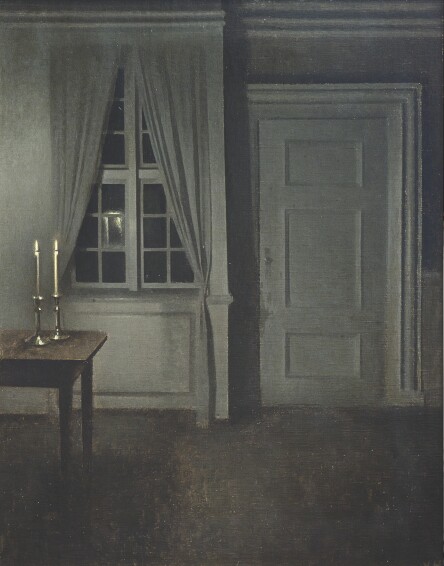- 31
Vilhelm Hammershøi
Description
- Vilhelm Hammershøi
- Interior with Two Candles
- signed with initials V.H. lower right
- oil on canvas
- 67.5 by 54cm., 26½ by 21¼in.
Provenance
Acquired by the parents-in-law of the present owner; thence by descent circa 1950
Exhibited
Tokyo, National Museum of Western Art, Vilhelm Hammershøi: The Poetry of Silence, 2008, no. 78, illustrated in the catalogue
Literature
Susanne Meyer-Abich, Vilhelm Hammershøi: Das malerische Werk, PhD thesis, Ruhr-Universität, Bochum, 1996, no. 247
Condition
"This lot is offered for sale subject to Sotheby's Conditions of Business, which are available on request and printed in Sotheby's sale catalogues. The independent reports contained in this document are provided for prospective bidders' information only and without warranty by Sotheby's or the Seller."
Catalogue Note
Painted in 1904, the present work depicts the artist's home in Strandgade 30, one of Hammershøi's most frequently painted and iconic subjects. Interior with Two Candles anticipates Møntsamleren (The Coin Collector) (fig. 1) also executed in 1904 and now housed in the Nasjonalmuseet, Oslo, which depicts the same room with a young man, modelled by the artist's younger brother Svend, examining a coin by the light of two burning candles. It is, however, the disappearance of physical human presence, alluded to by the burning candles, that embues the present work with an acutely haunting sense of lingering. As Hammershøi commented in 1907 on the subject of painting vacant rooms, 'I have always thought there was such beauty about a room like that, even though there weren't any people in it, perhaps precisely when there weren't any' (quoted in Vilhelm Hammershøi: The Poetry of Silence, exh. cat. Royal Academy of Arts, London, 2008, p. 23).
Interior with Two Candles illustrates Hammershøi's remarkable ability to capture an ambience of timelessness and introspective solitude, his observation of the etheral candlelight against the geometric forms and sharp angles of the apartment adding to the powerful effect. The sense of seclusion and introspection in Hammershøi's paintings is central to Symbolism, of which Hammershøi is now regarded as a leading exponent. In his observation of light and space he was influenced by James McNeill Whistler, whose work he first saw when exhibiting two of his own paintings at the Exposition Universelle in Paris in 1889. Hammershøi's influence, in turn, can be felt in the works of later artists, including Edward Hopper, Ida Lorentzen and Gerhard Richter (fig. 2).

